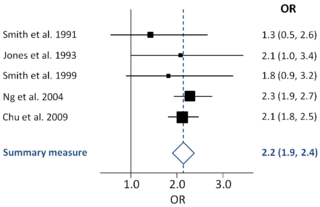Treatment effect may refer to:
| This disambiguation page lists articles associated with the title Treatment effect. If an internal link led you here, you may wish to change the link to point directly to the intended article. |
Treatment effect may refer to:
| This disambiguation page lists articles associated with the title Treatment effect. If an internal link led you here, you may wish to change the link to point directly to the intended article. |
Analysis of variance (ANOVA) is a collection of statistical models and their associated estimation procedures used to analyze the differences among group means in a sample. ANOVA was developed by statistician and evolutionary biologist Ronald Fisher. The ANOVA is based on the law of total variance, where the observed variance in a particular variable is partitioned into components attributable to different sources of variation. In its simplest form, ANOVA provides a statistical test of whether two or more population means are equal, and therefore generalizes the t-test beyond two means.

A meta-analysis is a statistical analysis that combines the results of multiple scientific studies. Meta-analysis can be performed when there are multiple scientific studies addressing the same question, with each individual study reporting measurements that are expected to have some degree of error. The aim then is to use approaches from statistics to derive a pooled estimate closest to the unknown common truth based on how this error is perceived. Existing methods for meta-analysis yield a weighted average from the results of the individual studies, and what differs is the manner in which these weights are allocated and also the manner in which the uncertainty is computed around the point estimate thus generated. In addition to providing an estimate of the unknown common truth, meta-analysis has the capacity to contrast results from different studies and identify patterns among study results, sources of disagreement among those results, or other interesting relationships that may come to light in the context of multiple studies.

A placebo is an inert substance or treatment which is designed to have no therapeutic value. Common placebos include inert tablets, inert injections, sham surgery, and other procedures.
In medicine, a side effect is an effect, whether therapeutic or adverse, that is secondary to the one intended; although the term is predominantly employed to describe adverse effects, it can also apply to beneficial, but unintended, consequences of the use of a drug. Developing drugs is a complicated process, because no two people are exactly the same, so even drugs that have virtually no side effects, might be difficult for some people. Also, it is difficult to make a drug that targets one part of the body but that doesn’t affect other parts, the fact that increases the risk of side effects in the untargeted parts.
An antiplatelet drug (antiaggregant), also known as a platelet agglutination inhibitor or platelet aggregation inhibitor, is a member of a class of pharmaceuticals that decrease platelet aggregation and inhibit thrombus formation. They are effective in the arterial circulation, where anticoagulants have little effect.

Beta blockers are a class of medications that are predominantly used to manage abnormal heart rhythms, and to protect the heart from a second heart attack after a first heart attack. They are also widely used to treat high blood pressure (hypertension), although they are no longer the first choice for initial treatment of most patients.
The power of a binary hypothesis test is the probability that the test rejects the null hypothesis (H0) when a specific alternative hypothesis (H1) is true. The statistical power ranges from 0 to 1, and as statistical power increases, the probability of making a type II error (wrongly failing to reject the null hypothesis) decreases. For a type II error probability of β, the corresponding statistical power is 1 − β. For example, if experiment 1 has a statistical power of 0.7, and experiment 2 has a statistical power of 0.95, then there is a stronger probability that experiment 1 had a type II error than experiment 2, and experiment 2 is more reliable than experiment 1 due to the reduction in probability of a type II error. It can be equivalently thought of as the probability of accepting the alternative hypothesis (H1) when it is true—that is, the ability of a test to detect a specific effect, if that specific effect actually exists. That is,
A route of administration in pharmacology and toxicology is the path by which a drug, fluid, poison, or other substance is taken into the body.

Minoxidil is a medication used for the treatment of male-pattern hair loss. It is an antihypertensive vasodilator. It is available as a generic medication and over the counter.
In statistics, an effect size is a quantitative measure of the magnitude of a phenomenon. Examples of effect sizes are the correlation between two variables, the regression coefficient in a regression, the mean difference, or even the risk with which something happens, such as how many people survive after a heart attack for every one person that does not survive. For most types of effect size, a larger absolute value always indicates a stronger effect, with the main exception being if the effect size is an odds ratio. Effect sizes complement statistical hypothesis testing, and play an important role in power analyses, sample size planning, and in meta-analyses. They are the first item (magnitude) in the MAGIC criteria for evaluating the strength of a statistical claim. Especially in meta-analysis, where the purpose is to combine multiple effect sizes, the standard error (S.E.) of the effect size is of critical importance. The S.E. of the effect size is used to weigh effect sizes when combining studies, so that large studies are considered more important than small studies in the analysis. The S.E. of the effect size is calculated differently for each type of effect size, but generally only requires knowing the study's sample size (N), or the number of observations in each group.

In statistics, an interaction may arise when considering the relationship among three or more variables, and describes a situation in which the effect of one causal variable on an outcome depends on the state of a second causal variable. Although commonly thought of in terms of causal relationships, the concept of an interaction can also describe non-causal associations. Interactions are often considered in the context of regression analyses or factorial experiments.

Betaxolol is a selective beta1 receptor blocker used in the treatment of hypertension and glaucoma. Being selective for beta1 receptors, it typically has fewer systemic side effects than non-selective beta-blockers, for example, not causing bronchospasm as timolol may. Betaxolol also shows greater affinity for beta1 receptors than metoprolol. In addition to its effect on the heart, betaxolol reduces the pressure within the eye. This effect is thought to be caused by reducing the production of the liquid within the eye. The precise mechanism of this effect is not known. The reduction in intraocular pressure reduces the risk of damage to the optic nerve and loss of vision in patients with elevated intraocular pressure due to glaucoma.

A scientific control is an experiment or observation designed to minimize the effects of variables other than the independent variable. This increases the reliability of the results, often through a comparison between control measurements and the other measurements. Scientific controls are a part of the scientific method.
In the design of experiments, treatments are applied to experimental units in a treatment group. In comparative experiments, members of a control group receive a standard treatment, a placebo, or no treatment at all. There may be more than one treatment group, more than one control group, or both.

A destination spa is a resort centered on a spa, such as a mineral spa. Historically many such spas were developed at the location of natural hot springs or mineral springs; in the era before modern biochemical knowledge and pharmacotherapy, "taking the waters" was often believed to have great medicinal powers. Even without such mystic powers, however, the stress relief and health education of spas also often has some degree of positive effect on health. Typically over a seven-day stay, such facilities provide a comprehensive program that includes spa services, physical fitness activities, wellness education, healthy cuisine, and special interest programming.
In fields such as epidemiology, social sciences, psychology and statistics, an observational study draws inferences from a sample to a population where the independent variable is not under the control of the researcher because of ethical concerns or logistical constraints. One common observational study is about the possible effect of a treatment on subjects, where the assignment of subjects into a treated group versus a control group is outside the control of the investigator. This is in contrast with experiments, such as randomized controlled trials, where each subject is randomly assigned to a treated group or a control group.

Isoetarine is a selective short-acting β2 adrenoreceptor agonist. It can be called the "granddaughter of adrenalin" in the line of β2 agonists that gave quick relief for bronchospasm and asthma. Epinephrine (adrenalin) was the first of these, and next came isoprenaline (isoproterenol). Isoetharine was the third drug in this line, thus the third generation or granddaughter of the original.

A forest plot, also known as a blobbogram, is a graphical display of estimated results from a number of scientific studies addressing the same question, along with the overall results. It was developed for use in medical research as a means of graphically representing a meta-analysis of the results of randomized controlled trials. In the last twenty years, similar meta-analytical techniques have been applied in observational studies and forest plots are often used in presenting the results of such studies also.

Brexpiprazole, sold under the brand name Rexulti, is an atypical antipsychotic. It is a dopamine D2 receptor partial agonist and has been described as a "serotonin–dopamine activity modulator" (SDAM). The drug received FDA approval on July 13, 2015 for the treatment of schizophrenia, and as an adjunctive treatment for depression. It has been designed to provide improved efficacy and tolerability (e.g., less akathisia, restlessness and/or insomnia) over established adjunctive treatments for major depressive disorder (MDD).
Parchmentising is a textile finishing treatment for cellulose fabric, mainly cotton and flax, which stiffens the fabric and imparts a degree of translucency.